|
January, 16th 2020
12.30 h
Auditorium Campus Poblenou
Video to be linked in short
|
"Integration, multi-disciplinary and Open Science in biomedical engineering"
by Oscar Camara Rey
According to the Online Etimology Dictionary, the word "integration" (1610s) is defined as the "act of bringing together the parts of a whole" from French intégration and directly from Late Latin integrationem (nominative integratio) "renewal, restoration," noun of action from past participle stem of Latin integrare "make whole," also "renew, begin again". It is natural to relate these terms to multi-disciplinarity in research, especially in some fields such as biomedical engineering. Personally, my main research interests have always involved the integration of knowledge from different disciplines such as mathematical modelling, numerical methods and data processing, aiming at potential translation of the developed computational tools to a clinical environment. Moreover, this tendency for lack of specialization (not positive sometimes) has led me to work on several medical domains such as oncology, neurology and cardiology, reaching a more holistic view of the human body (and often “beginning again” into a new research field from scratch). During the seminar I will present some of these integrative projects, also emphasizing the benefits (and challenges) of Open Science to facilitate collaborations by bringing together researchers rather than competing each other.
|
|
June, 6th 2019
15.00 h
Auditorium Campus Poblenou
|
"Big Data, Machine Learning and Justice"
by Ricardo Baeza-Yates
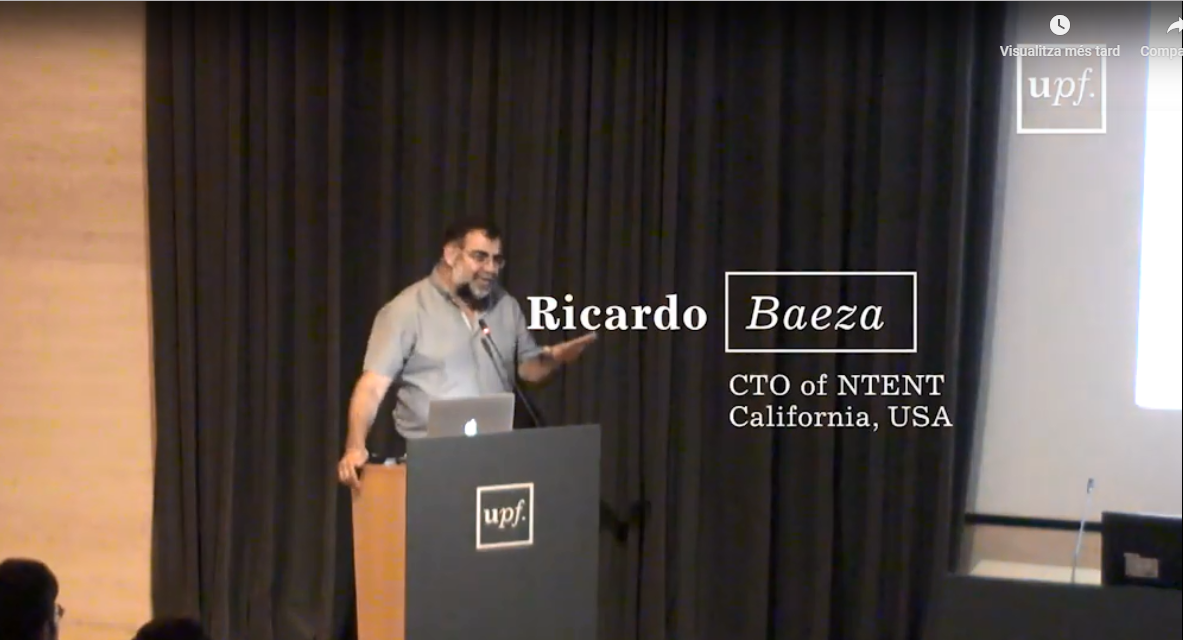 In this presentation we start with the main challenges of using big data and machine learning, including scalability and fairness. We exemplify these challenges analyzing how machine learning has been applied in justice and how human biases are exposed by models that learn from human data. However, even though these models are not perfect, they are many times better than humans because they are always coherent in their decisions. We will finish with some bad and good practices that should be avoided or enforced, respectively, when training machine learning models. In this presentation we start with the main challenges of using big data and machine learning, including scalability and fairness. We exemplify these challenges analyzing how machine learning has been applied in justice and how human biases are exposed by models that learn from human data. However, even though these models are not perfect, they are many times better than humans because they are always coherent in their decisions. We will finish with some bad and good practices that should be avoided or enforced, respectively, when training machine learning models.
References:
- Berk at al. Fairness in Criminal Justice Risk Assessments: The State of the Art. Sociological Methods & Research 1-42, 2018. https://arxiv.org/abs/1703.09207
- Kleinberg et al. Human Decisions and Machine Predictions, Quarterly Journal of Economics, 237-293, 2018. https://www.nber.org/papers/w23180
|
|
December, 4th 2018
12.30 h
Auditorium Campus Poblenou
|
"Manifold learning for image registration and population analysis"
by Gemma Piella
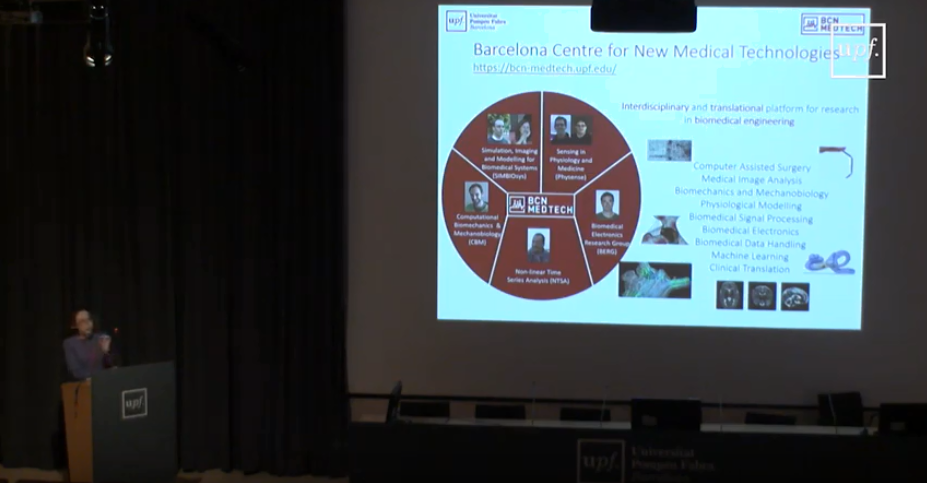 The variation observed in high-dimensional data can be often described by a low number of parameters. Revealing the low-dimensional representation of such high dimensional data not only leads to a much compact description but also helps us understand the underlying structure of the data and the process that generated them. Manifold learning techniques target the conversion of data from high to lower dimensional representations while preserving the intrinsic geometry of the data space. As a result, the new embedding space may simplify further analysis, for example for data mining, pattern recognition or knowledge discovery. In this talk, I will overview some of the research we have done in this line and how these techniques can be used for image registration and population analysis. The variation observed in high-dimensional data can be often described by a low number of parameters. Revealing the low-dimensional representation of such high dimensional data not only leads to a much compact description but also helps us understand the underlying structure of the data and the process that generated them. Manifold learning techniques target the conversion of data from high to lower dimensional representations while preserving the intrinsic geometry of the data space. As a result, the new embedding space may simplify further analysis, for example for data mining, pattern recognition or knowledge discovery. In this talk, I will overview some of the research we have done in this line and how these techniques can be used for image registration and population analysis.
|
|
May 24th, 2018
12:30
Auditorium Campus Poblenou
|
"A Journey through Musical Computational Creativity"
by Sergi Jordà
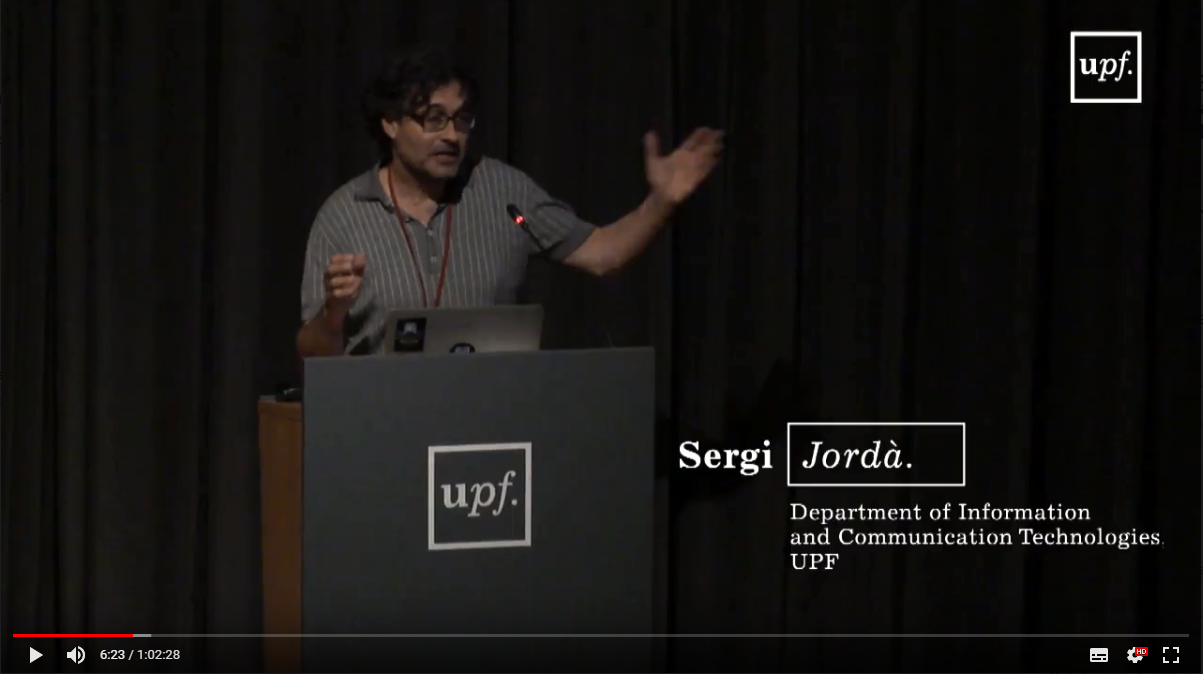 Computational or artificial creativity is a multidisciplinary field of research located at the intersection of artificial intelligence, cognitive psychology, philosophy, and the arts. Although the term was officially coined in the late 90s, the study of the use of computers for simulating or enhancing human creativity dates back from the 50s, initially inspired by the work of cyberneticists such as Weiner or Shannon. For the last 30 years, my own personal work has mainly focused on exploring, from multiples perspectives, the capabilities of computers for enhancing or complementing (though never mimicking) human musical creativity. Computational or artificial creativity is a multidisciplinary field of research located at the intersection of artificial intelligence, cognitive psychology, philosophy, and the arts. Although the term was officially coined in the late 90s, the study of the use of computers for simulating or enhancing human creativity dates back from the 50s, initially inspired by the work of cyberneticists such as Weiner or Shannon. For the last 30 years, my own personal work has mainly focused on exploring, from multiples perspectives, the capabilities of computers for enhancing or complementing (though never mimicking) human musical creativity.
In this seminar, I will first introduce the context and motivation of my work, and review some of the more notable results obtained along these three decades. I will then discuss more in depth a recent study we have carried for better understanding how do we perceive rhythm, with the subsequent development of artificial expert drumming agents aimed at assisting music production.
|
|
February 21st, 2018
12:30
Auditorium
|
"Conceptualizing the Internet of Things"
by Rafael Pous
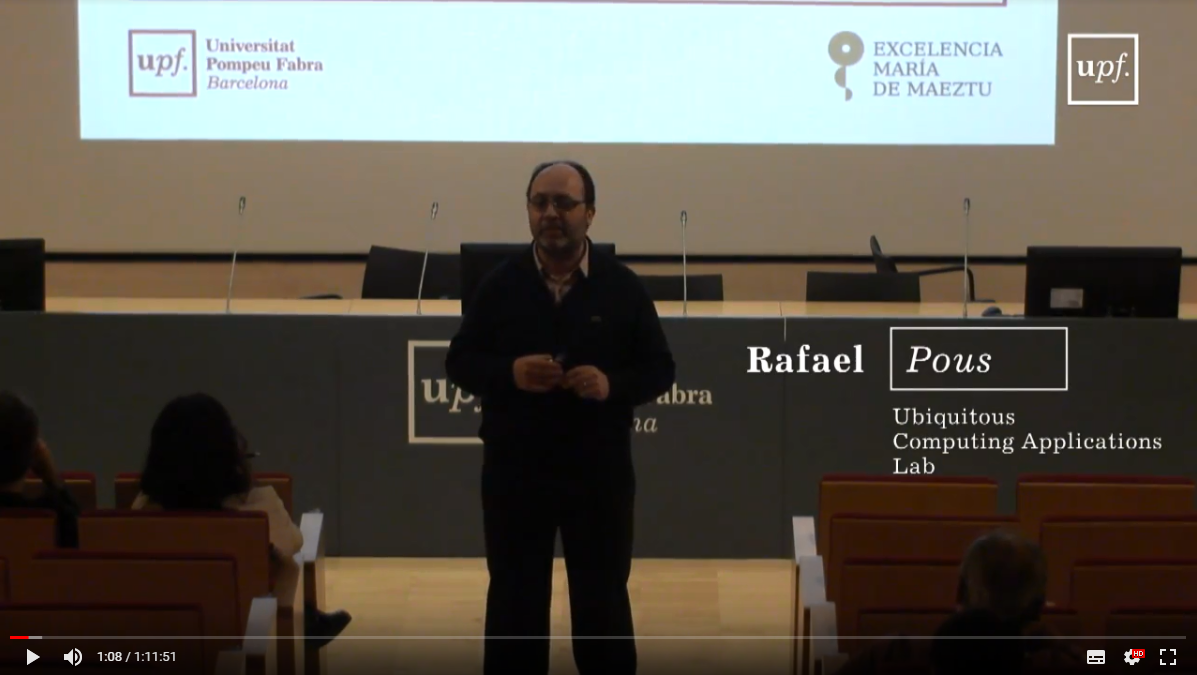 As it happens with all research disciplines when they are at the peak of Gartner’s hype cycle, the Internet of Things (IoT) still means a lot of different things to a lot of different people. That is because the IoT brand was created as the umbrella for a lot of different use cases, real and imaginary, but there is still not a clear consensus on what the Internet of Things is, and specially about what it is not. During the lecture, a conceptual model of the IoT will be introduced, along with a proposed taxonomy for IoT use cases. Additionally, the concept of “identity”, key in establishing IoT use cases, will be discussed. As it happens with all research disciplines when they are at the peak of Gartner’s hype cycle, the Internet of Things (IoT) still means a lot of different things to a lot of different people. That is because the IoT brand was created as the umbrella for a lot of different use cases, real and imaginary, but there is still not a clear consensus on what the Internet of Things is, and specially about what it is not. During the lecture, a conceptual model of the IoT will be introduced, along with a proposed taxonomy for IoT use cases. Additionally, the concept of “identity”, key in establishing IoT use cases, will be discussed.
|
|
December 14th, 2017
12:30
Auditorium
|
"The power of giving, my career and impacting the communities I serve"
by Dorcas Muthoni
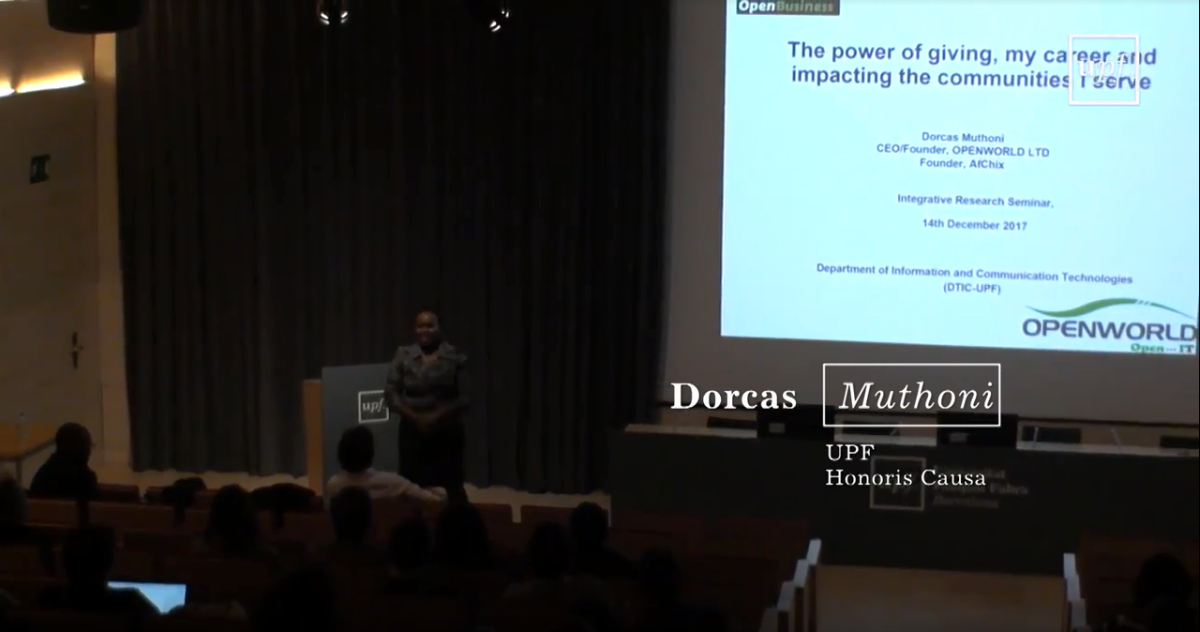 It does not really bother me to know it feels good to help someone else.This, to me, is a completely acceptable type of selfishness. Through my day to day work as an entrepreneur and computer scientist, I seek to see technology positively transforming the lives of It does not really bother me to know it feels good to help someone else.This, to me, is a completely acceptable type of selfishness. Through my day to day work as an entrepreneur and computer scientist, I seek to see technology positively transforming the lives ofthe African society, governments and enterprises. Dorcas Muthoni, Dr. Honoris Causa, UPF.
|
|
November 30th, 2017
12:30
Auditorium
|
When the body acquires meaning: Full-Body Interaction Design
by Narcís Parés
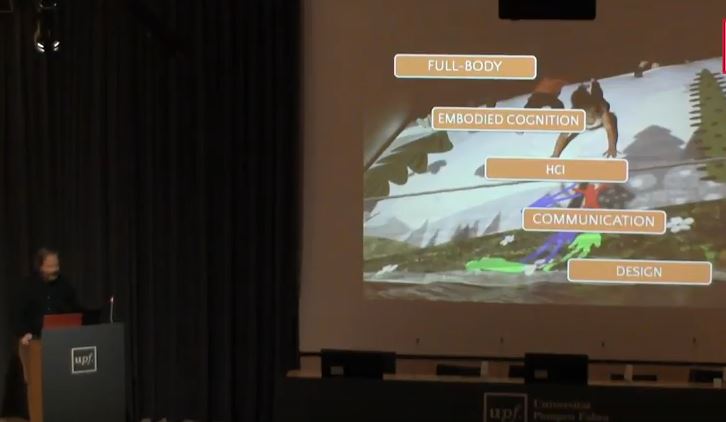 Despite some visionares in HCI, such as Buxton (1986) and Grudin (1990), have long been claiming the importance of the body in the human-computer interaction relationship, this discipline has mostly incorporated the body from a very superficial or banal stance. Superficial, as the body has often been used merely as a cursor within a digital world, ignoring the spatial, kinesthetic, proprioceptive and social qualities that could provide greater depth and richness to the experience. Banal, since the activity of the body in interaction has very often suffered the literality of simulation in the proposed experiences. Although in his seminal work Dourish (2001) proposed the notion of Embodied Interaction, in practice HCI has not yet taken full advantage of the trajectories of other disciplines which are steps ahead in thinking about the relationships between the body, the mind, and the world. Disciplines such as philosophy, developmental psychology, linguistics or neuroscience have provided important clues on how our mind and body are interrelated, how the two together relate to the surrounding environment and develop within it, and how they relate to other living beings. Despite some visionares in HCI, such as Buxton (1986) and Grudin (1990), have long been claiming the importance of the body in the human-computer interaction relationship, this discipline has mostly incorporated the body from a very superficial or banal stance. Superficial, as the body has often been used merely as a cursor within a digital world, ignoring the spatial, kinesthetic, proprioceptive and social qualities that could provide greater depth and richness to the experience. Banal, since the activity of the body in interaction has very often suffered the literality of simulation in the proposed experiences. Although in his seminal work Dourish (2001) proposed the notion of Embodied Interaction, in practice HCI has not yet taken full advantage of the trajectories of other disciplines which are steps ahead in thinking about the relationships between the body, the mind, and the world. Disciplines such as philosophy, developmental psychology, linguistics or neuroscience have provided important clues on how our mind and body are interrelated, how the two together relate to the surrounding environment and develop within it, and how they relate to other living beings.
In this seminar I will briefly address some of these conceptual contributions to then move onto interaction design, as a design discipline, and full-body interaction as a communicational medium that takes advantage of the aforementioned relationships. I will provide a very brief panorama of my work in this area in the last 15 years to then focus on one specific ongoing project that applies Full-Body Interaction to foster social initiation in children in the Autism Spectrum Condition.
|
|
October 24th, 2017
12:30
Auditorium
|
Towards 5G Wireless Networks
by Angel Lozano
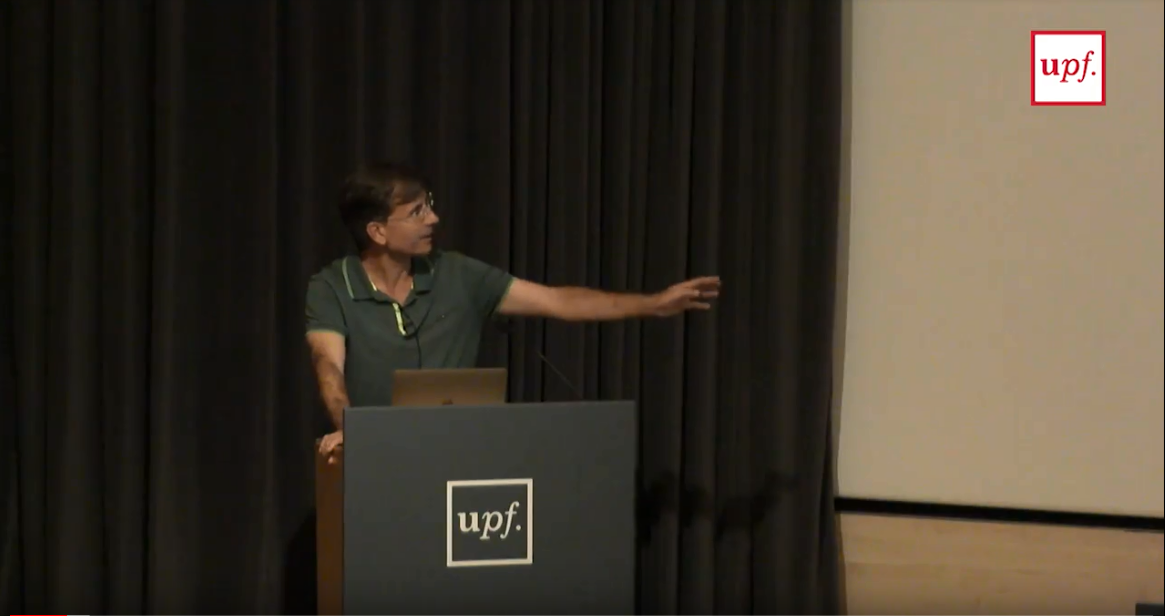 Over the last couple of decades, wireless communications have exploded into what is arguably the biggest technological revolution in history. Indeed, the pace of adoption of the cellular phone dwarfs those of other momentous devices such as the TV or the personal computer. Now, with the 4th Generation of wireless networks in service, challenges keep mounting as user expectations grow with competing demands for higher bit rates, vastly enlarged capacities, vanishing latencies, and uniform user experiences. This lecture the upcoming 5th Generation and propounds that it should transcend the cellular structure that has ruled wireless communications to date, and usher in a new age of post-cellular networks. Over the last couple of decades, wireless communications have exploded into what is arguably the biggest technological revolution in history. Indeed, the pace of adoption of the cellular phone dwarfs those of other momentous devices such as the TV or the personal computer. Now, with the 4th Generation of wireless networks in service, challenges keep mounting as user expectations grow with competing demands for higher bit rates, vastly enlarged capacities, vanishing latencies, and uniform user experiences. This lecture the upcoming 5th Generation and propounds that it should transcend the cellular structure that has ruled wireless communications to date, and usher in a new age of post-cellular networks.
|
|
June 29th, 2017
12:30
Auditorium
|
The Role of Expectations in Economics
by Jordi Galí
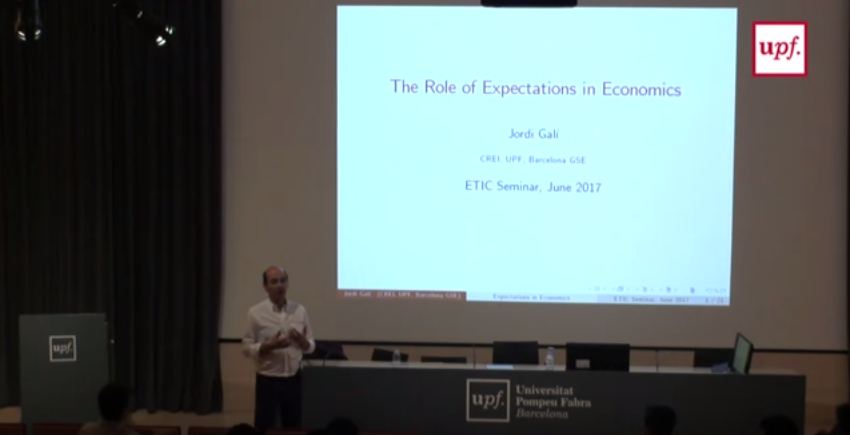
In this lecture I will discuss a distinctive feature of economic environments (vs. physical environements): the dynamics of an economy depend on forward-looking decisions, which in trun require that agents form expectations about future individual and aggregate variables. I will introduce the concept of rational expectations and discuss some of the associated economic phenomena, including indeterminacy, sunspot fluctuations, and bubbles.
Bio
Director, Centre de Recerca en Economia Internacional (CREI)
|
|
Wed
April 26th, 2017
12:30
Auditorium
|
Synthesizing consciousness: science, technology and society
by Paul F.M.J. Verschure
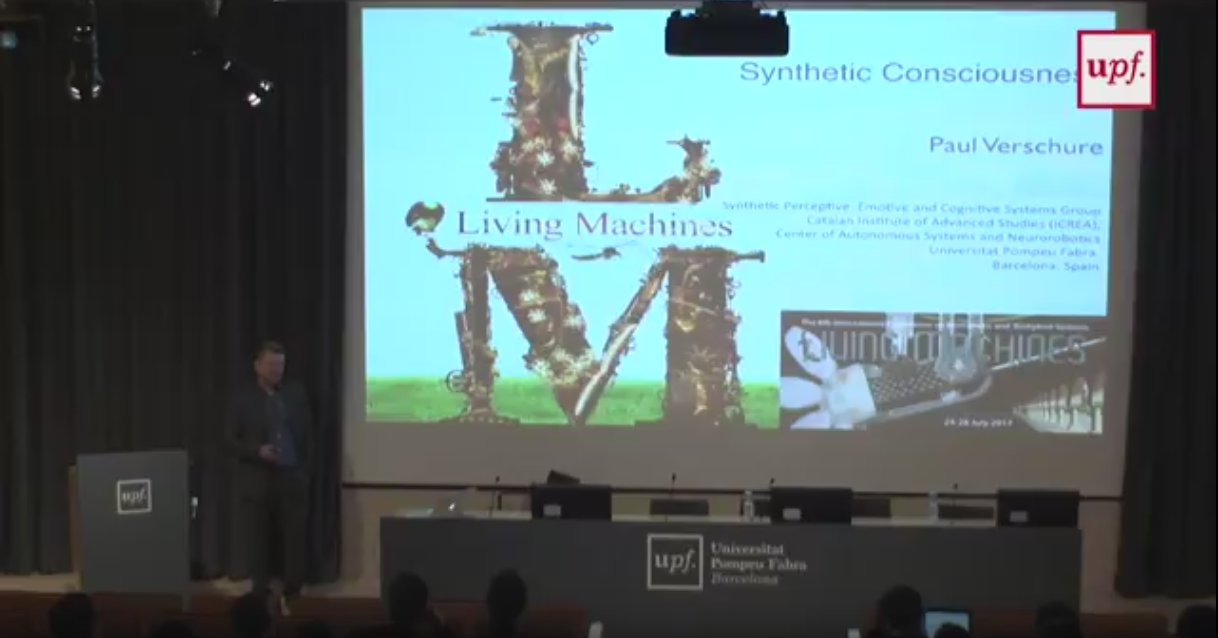 Understanding the nature of consciousness is one of the grand outstanding scientific challenges of great importance both to understand who we are and of significant practical value. The fundamental methodological problem is how phenomenal first person experience can be accounted for in a third person verifiable form, while the conceptual challenge is to both define its function and physical realization. The Distributed Adaptive Control theory of consciousness (DACtoc) proposes answers to these three challenges that will be presented in this talk. I will highlight some of the functional and mechanistic aspects of DACtoc showing how DACtoc has informed our understanding of core brain mechanisms of perception, cognition and action and given rise to one of the most effective neurorehabilitation method available today. An important consequence of DACtoc is that if we aim to build socially capable machines they must become conscious raising further important questions on how we can co-exist with them. Understanding the nature of consciousness is one of the grand outstanding scientific challenges of great importance both to understand who we are and of significant practical value. The fundamental methodological problem is how phenomenal first person experience can be accounted for in a third person verifiable form, while the conceptual challenge is to both define its function and physical realization. The Distributed Adaptive Control theory of consciousness (DACtoc) proposes answers to these three challenges that will be presented in this talk. I will highlight some of the functional and mechanistic aspects of DACtoc showing how DACtoc has informed our understanding of core brain mechanisms of perception, cognition and action and given rise to one of the most effective neurorehabilitation method available today. An important consequence of DACtoc is that if we aim to build socially capable machines they must become conscious raising further important questions on how we can co-exist with them.
I will also give a short overview of the history of SPECS at DTIC covering 2006-2017 and explain why we are now planning a move to IBEC.
References:1. Verschure, P.F.M.J., Synthetic consciousness: the distributed adaptive control perspective. Philosophical Transactions of the Royal Society B: Biological Sciences, 2016. 371.
|
Thu
March 30th, 2017
12:30
Auditorium |
Technology-enhanced music learning, health and well-being
by Rafael Ramirez
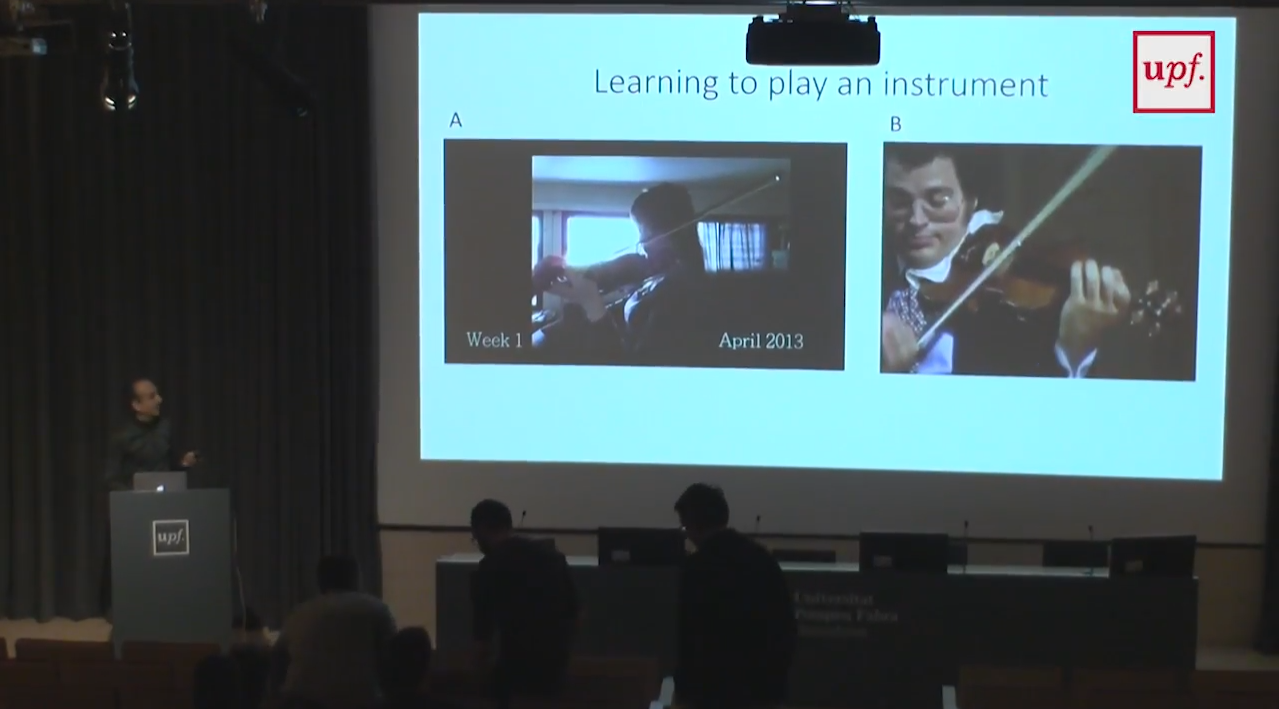 Learning to play a musical instrument has been showed to provide several benefits for acquiring non-musical skills. However, there is a lack of generalised access to music education, and musical instrument learning is mostly based on the master-apprentice model in which the student’s interaction and socialization is often restricted to short and punctual contact with the teacher followed by long periods of self-study resulting in high abandonment rates. In such scenario, modern technologies are rarely employed and almost never go beyond audio and video recording. Our research aims to study how we learn musical instruments from a pedagogical and scientific perspective in order to create new interactive, assistive, self-learning, augmented-feedback, and social-aware systems complementary to traditional teaching. The aim is to allow more people to have access to music education, including people with motor disabilities, and reduce abandonment rates among music students. In this seminar, I will take the opportunity to present some of the research carried out in our research lab on areas such as technology-enhanced music learning, expressive performance modelling, accessible music interfaces, as well as some applications to health and well-being. Learning to play a musical instrument has been showed to provide several benefits for acquiring non-musical skills. However, there is a lack of generalised access to music education, and musical instrument learning is mostly based on the master-apprentice model in which the student’s interaction and socialization is often restricted to short and punctual contact with the teacher followed by long periods of self-study resulting in high abandonment rates. In such scenario, modern technologies are rarely employed and almost never go beyond audio and video recording. Our research aims to study how we learn musical instruments from a pedagogical and scientific perspective in order to create new interactive, assistive, self-learning, augmented-feedback, and social-aware systems complementary to traditional teaching. The aim is to allow more people to have access to music education, including people with motor disabilities, and reduce abandonment rates among music students. In this seminar, I will take the opportunity to present some of the research carried out in our research lab on areas such as technology-enhanced music learning, expressive performance modelling, accessible music interfaces, as well as some applications to health and well-being.
|
|
Thu
Feb 23rd, 2017
12:30
Auditorium
|
Overwhelmed by Information? Summarization, Simplification and information extraction at your fingertips
by Horacio Saggion
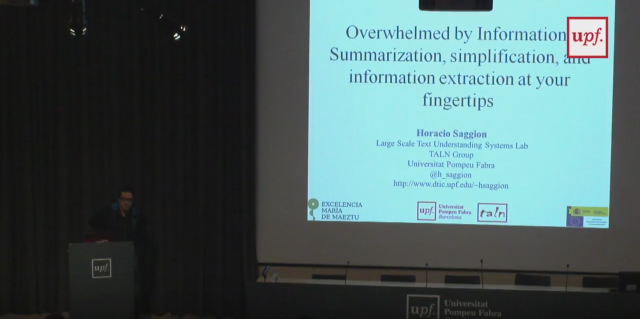 On-line news, social networks’ posts, e-mails, Wikipedia pages, .... the amount of information available on-line is growing at unprecedented rates. In this context of information overload, automatic text summarization and information extraction are key Natural Language Processing (NLP) techniques for extracting the most salient information from a document in order to populate knowledge repositories or provide users with brief stand-alone document surrogates. On-line news, social networks’ posts, e-mails, Wikipedia pages, .... the amount of information available on-line is growing at unprecedented rates. In this context of information overload, automatic text summarization and information extraction are key Natural Language Processing (NLP) techniques for extracting the most salient information from a document in order to populate knowledge repositories or provide users with brief stand-alone document surrogates.
Besides the amount of text we have to deal with daily, there is a further problem: certain types of texts such as news, which are produced for a general audience, may be too difficult to read and understand by some people, because these texts have a complex vocabulary and grammar. In this context, automatic text simplification is another NLP technique which aims at transforming a text into an equivalent which, using a simpler vocabulary or syntax, would be easier to read and understand.
Over the past years, we have been working on two lines of research; on the one hand, we have investigated ways to extract and condense the essential information from massive scientific literature and, on the other hand, we have carried out research to produce multilingual, adaptable, text simplification solutions for digital inclusion. In this seminar, I will take the opportunity to present the work carried out on our research lab on these two distinctive, exciting, and relevant topics in the information society
|
|
Thu
Jan 26th, 2017
12:30
Auditorium
|
Ontogenesis of rational thinking
by Luca Bonatti
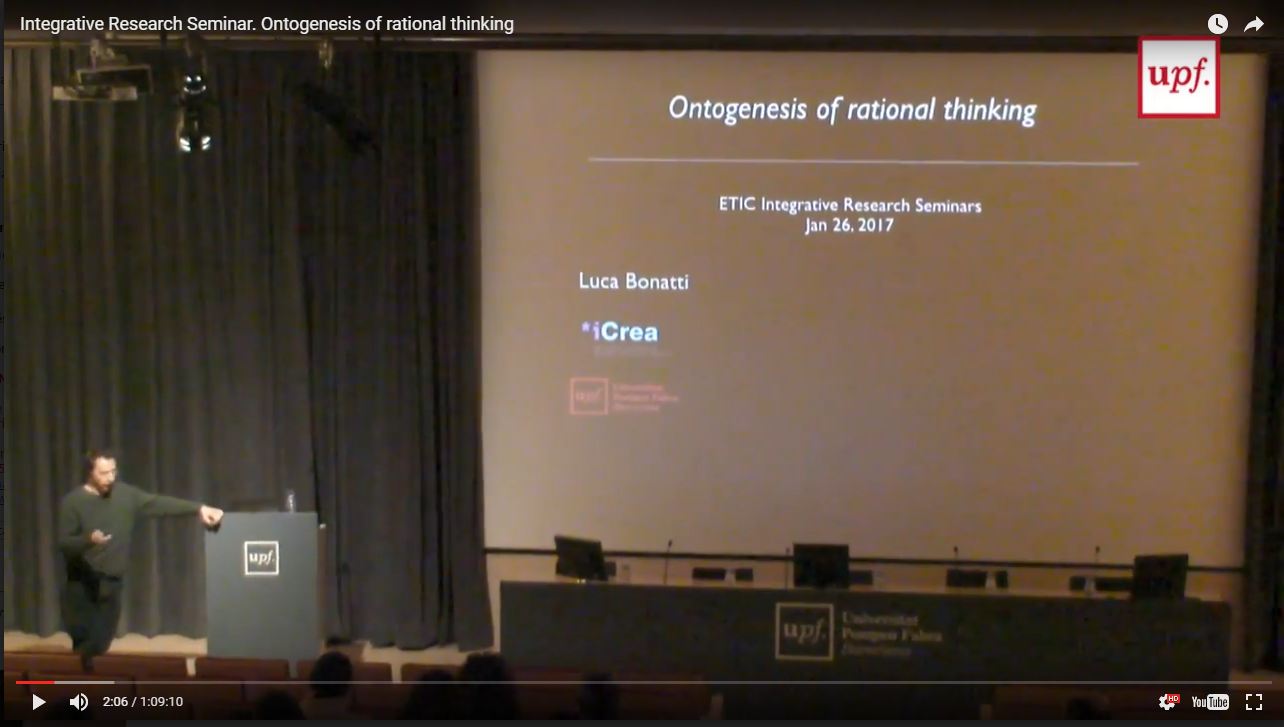 Infants possess several mechanisms to solve domain-specific problems. However, little is know about infants' abilities to reason beyond these limited domains. I will present evidence that suggests that infants have a early sense of rationality. Furthermore, when they witness a scene not previously experienced, infants reason about it by applying basic logical principles. I will argue that such inferences are used to build strategies to inspect the scenes and make inferences to enrich knowledge. I will present data about the behavioral correlates of this inferential processes in infants and adults, focusing on the case of disjunctive reasoning. Finally, I will argue that any well-designed system for human-machine interaction has to embody a model of the cognitive state of a human, in her adult and infant state. Infants possess several mechanisms to solve domain-specific problems. However, little is know about infants' abilities to reason beyond these limited domains. I will present evidence that suggests that infants have a early sense of rationality. Furthermore, when they witness a scene not previously experienced, infants reason about it by applying basic logical principles. I will argue that such inferences are used to build strategies to inspect the scenes and make inferences to enrich knowledge. I will present data about the behavioral correlates of this inferential processes in infants and adults, focusing on the case of disjunctive reasoning. Finally, I will argue that any well-designed system for human-machine interaction has to embody a model of the cognitive state of a human, in her adult and infant state.
|
|
Thu
Jun 16th, 2016
12:30
Auditorium
|
General Solvers for General Artificial Intelligence
by Hector Geffner
 Artificial Intelligence (AI) is suddenly everywhere with large corporations investing heavily in AI. Progress in many aspects of AI has been remarkable indeed yet the achievements hide a crucial limitation: the systems that excel at specific skills as a result of powerful learning algorithms are not intelligent in a broad sense. Truly flexible intelligent systems must be intentional and use predictive models and goals for different purposes: for generating behavior, for interpreting the behavior of others (humans or not), for sensing and communicating, and for learning. Learning from examples and from punishments and rewards are crucial, yet human learning is mostly about how the physical and social worlds work. In this talk, I'll review some of the progress and challenges in artificial intelligence, and our efforts aimed at achieving general artificial intelligence through the formulation and development of general effective solvers. Artificial Intelligence (AI) is suddenly everywhere with large corporations investing heavily in AI. Progress in many aspects of AI has been remarkable indeed yet the achievements hide a crucial limitation: the systems that excel at specific skills as a result of powerful learning algorithms are not intelligent in a broad sense. Truly flexible intelligent systems must be intentional and use predictive models and goals for different purposes: for generating behavior, for interpreting the behavior of others (humans or not), for sensing and communicating, and for learning. Learning from examples and from punishments and rewards are crucial, yet human learning is mostly about how the physical and social worlds work. In this talk, I'll review some of the progress and challenges in artificial intelligence, and our efforts aimed at achieving general artificial intelligence through the formulation and development of general effective solvers.
|
|
Fri
May 6th, 2017
12:00
Auditorium
|
Can we decode the brain?
by Ruben Moreno
 One of the highest hopes of theorists of the brain is to be able to decipher what a person or animal feels, thinks or wishes by using neuronal activity. If this were possible, then we could argue that we have understood the ‘neuronal code’, the set of symbols that the brain uses to represent and transform information. We are still very far from this desideratum to become true. However, I will describe some small steps that our lab are taking to advance into that territory.; One of the highest hopes of theorists of the brain is to be able to decipher what a person or animal feels, thinks or wishes by using neuronal activity. If this were possible, then we could argue that we have understood the ‘neuronal code’, the set of symbols that the brain uses to represent and transform information. We are still very far from this desideratum to become true. However, I will describe some small steps that our lab are taking to advance into that territory.;
|
|
Apr 7th, 2016
12:30
Auditorium
|
From medical images to digital patients and robotic surgeons
by Miguel A. Gonzalez Ballester
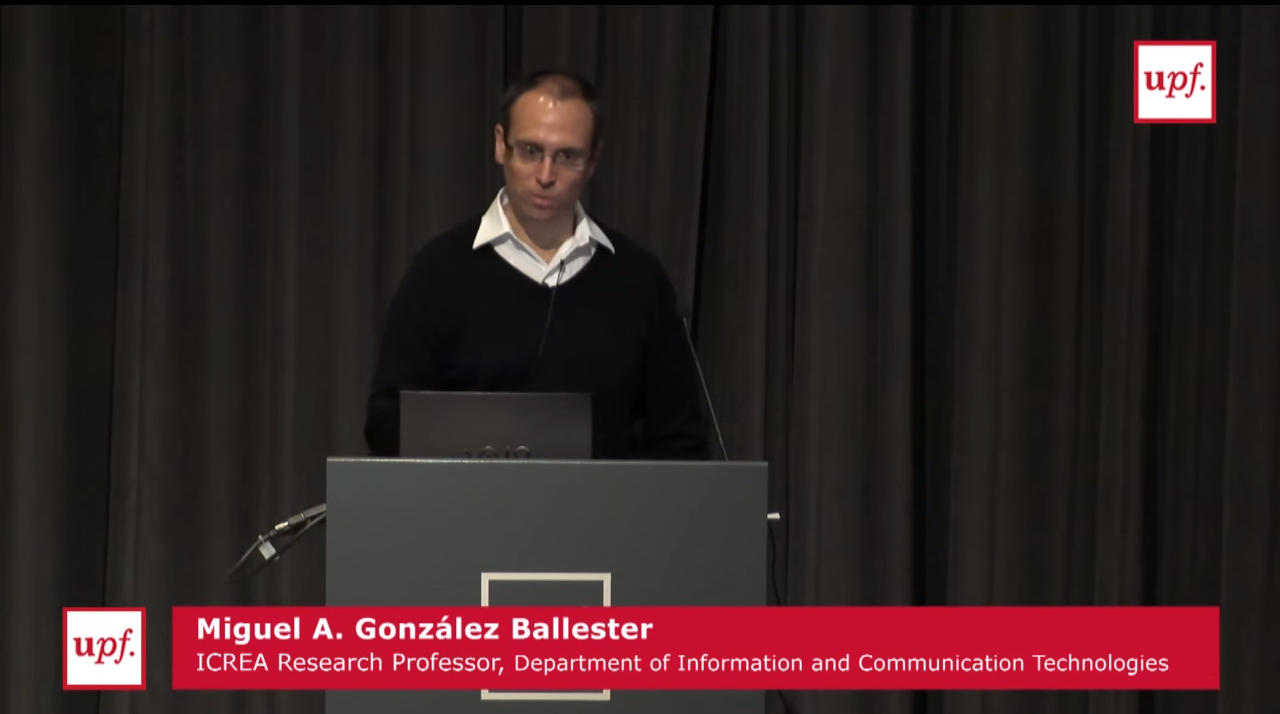 Modern medical imaging technologies make it possible to explore the human body in a multitude of ways, depicting anatomy, metabolic function and pathological processes. Innovations in medical imaging have been paralleled by the development of computer-based image processing methods to automatically detect and diagnose pathologies, quantify disease progression and assess possible risks and complications when planning a surgical intervention. Computer support for treatment planning is not limited to image processing (filtering, segmentation, registration), but also includes artificial intelligence (machine learning, decision support systems), mathematical and computational models (statistical shape models, finite element simulations) and hardware (tracking and guidance systems, mechatronic and robotic devices). All these tools can be combined to assist in diagnosis and treatment and guide the surgeon in the operating room. In this talk, we will see examples of these techniques applied to orthopaedics, heart failure, neurodegenerative diseases, cochlear implants and foetal surgery. Modern medical imaging technologies make it possible to explore the human body in a multitude of ways, depicting anatomy, metabolic function and pathological processes. Innovations in medical imaging have been paralleled by the development of computer-based image processing methods to automatically detect and diagnose pathologies, quantify disease progression and assess possible risks and complications when planning a surgical intervention. Computer support for treatment planning is not limited to image processing (filtering, segmentation, registration), but also includes artificial intelligence (machine learning, decision support systems), mathematical and computational models (statistical shape models, finite element simulations) and hardware (tracking and guidance systems, mechatronic and robotic devices). All these tools can be combined to assist in diagnosis and treatment and guide the surgeon in the operating room. In this talk, we will see examples of these techniques applied to orthopaedics, heart failure, neurodegenerative diseases, cochlear implants and foetal surgery.
|
Mar 17th, 2016
13:00
Auditorium |
Musical information retrieval: Challenges, opportunities, and classical music
by Emilia Gomez
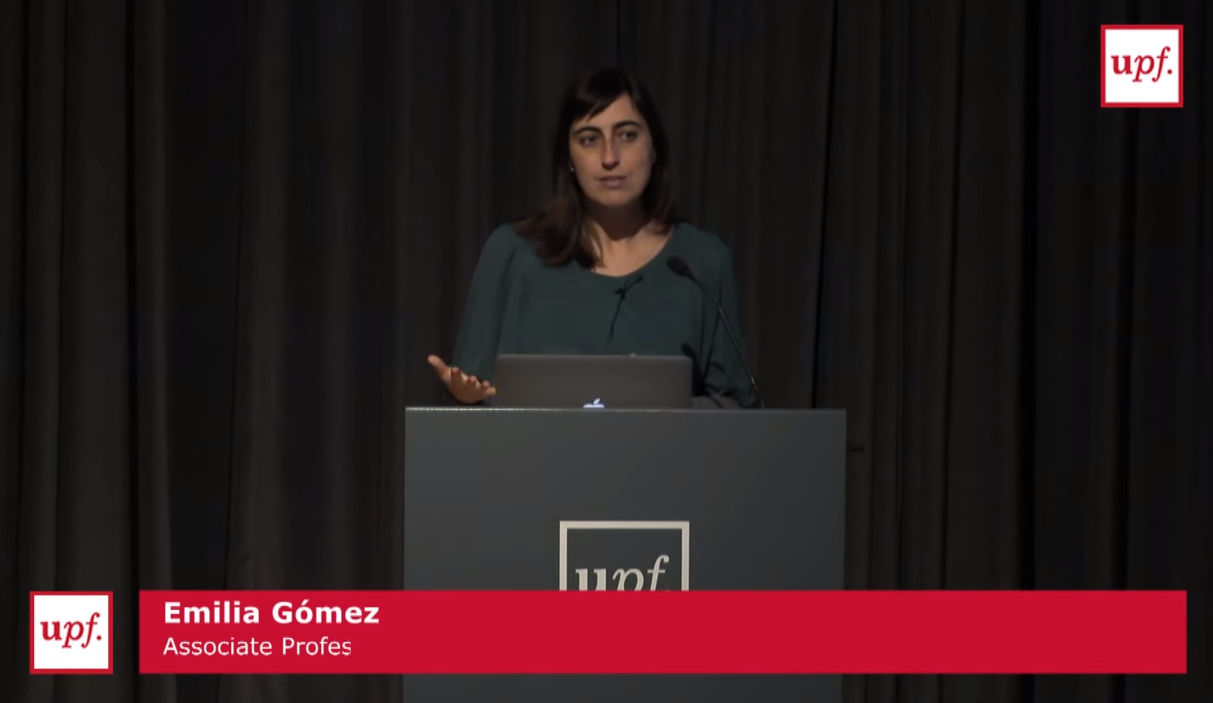 Music Information Retrieval (MIR) focuses on the research and development of computational systems to help humans better make sense of “big” music data, drawing from a diverse set of disciplines, including music theory, computer science, psychology, neuroscience, library science, electrical engineering, and machine learning. In this talk, I will provide a survey of some of my research findings in MIR that illustrate the current paradigm shift: from signal to multimodal music descriptions, from lab settings to ecologically valid evaluations, and from system-oriented to user-centric music retrieval and recommendation approaches. I will make a special emphasis on our research on the PHENICX EU project, which exploits MIR techniques to change the way we experience classical music concerts. Music Information Retrieval (MIR) focuses on the research and development of computational systems to help humans better make sense of “big” music data, drawing from a diverse set of disciplines, including music theory, computer science, psychology, neuroscience, library science, electrical engineering, and machine learning. In this talk, I will provide a survey of some of my research findings in MIR that illustrate the current paradigm shift: from signal to multimodal music descriptions, from lab settings to ecologically valid evaluations, and from system-oriented to user-centric music retrieval and recommendation approaches. I will make a special emphasis on our research on the PHENICX EU project, which exploits MIR techniques to change the way we experience classical music concerts.
|
Feb 18th, 2016
12:30
Auditorium |
Healing signals: Delivery of electric current for therapeutics
by Antoni Ivorra
![Video youtube]() Although flow of electric current through the human body must be generally perceived as dangerous, it must be noted that controlled delivery of electric currents is the basis of some diagnostic and therapeutic approaches of great impact. Clinical applications are very diverse in terms of aim and features of the delivered currents. For instance, pacemakers deliver low magnitude and low frequency current pulses to regulate the beating of the heart whereas so called electrosurgical scalpels deliver high current RF bursts to cut biological tissues. In this talk, I will overview some fundamental interactions between living organisms and electric currents and I will briefly present the research we – the Biomedical Electronics Research Group – are conducting for understanding these interactions and for making use of them to develop new methods and devices for therapeutics. In particular, I will focus on the electroporation phenomenon and how it can be engineered for cancer treatments and on neuromuscular stimulation for neuroprosthetics by means of injectable wireless devices. Although flow of electric current through the human body must be generally perceived as dangerous, it must be noted that controlled delivery of electric currents is the basis of some diagnostic and therapeutic approaches of great impact. Clinical applications are very diverse in terms of aim and features of the delivered currents. For instance, pacemakers deliver low magnitude and low frequency current pulses to regulate the beating of the heart whereas so called electrosurgical scalpels deliver high current RF bursts to cut biological tissues. In this talk, I will overview some fundamental interactions between living organisms and electric currents and I will briefly present the research we – the Biomedical Electronics Research Group – are conducting for understanding these interactions and for making use of them to develop new methods and devices for therapeutics. In particular, I will focus on the electroporation phenomenon and how it can be engineered for cancer treatments and on neuromuscular stimulation for neuroprosthetics by means of injectable wireless devices.
|
Jan 14th, 2016
12:30
Auditorium |
Towards a global model of brain activity: Lessons from the human connectome
by Gustavo Deco
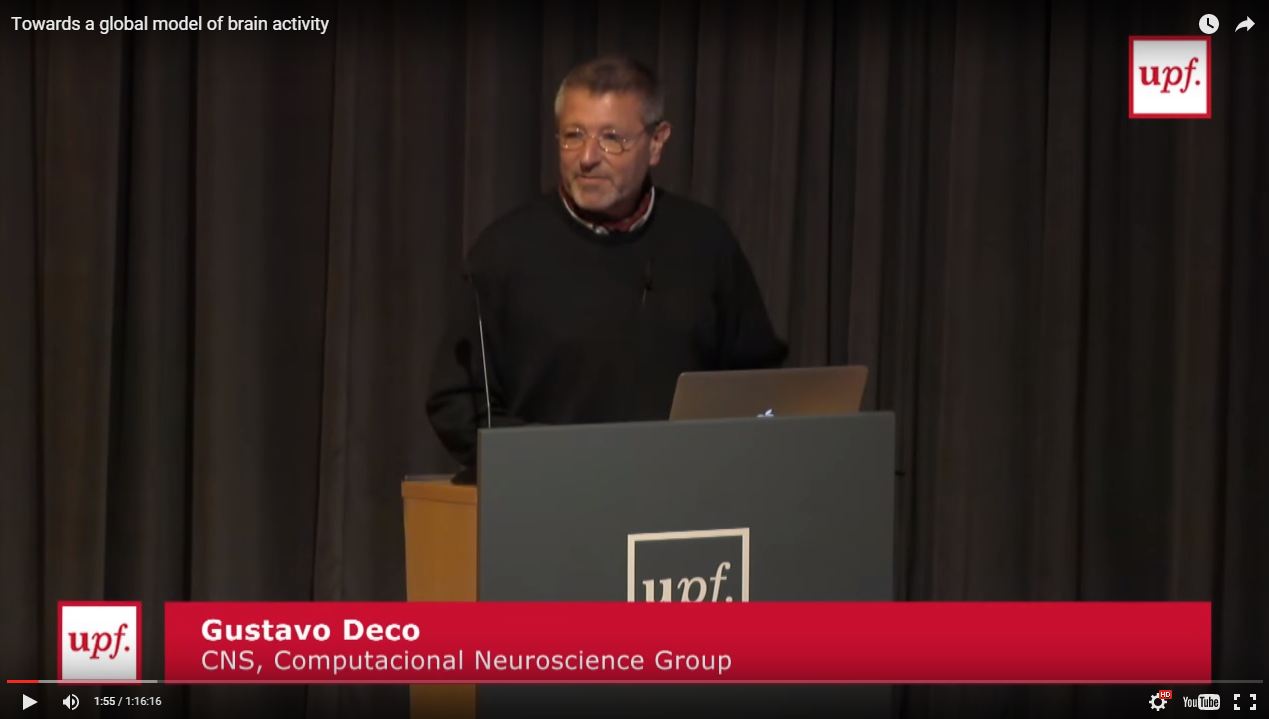 Since the mid 1990s, the intriguing dynamics of the brain at rest has been attracting a growing body of research in neuroscience. Neuroimaging studies have revealed distinct functional networks that slowly activate and deactivate, pointing to the existence of an underlying network dynamics emerging spontaneously during rest, with specific spatial, temporal and spectral characteristics. Several theoretical scenarios have been proposed and tested with the use of large-scale computational models of coupled brain areas. However, a mechanistic explanation that encompasses all the phenomena observed in the brain during rest is still to come.We provide in this talk an overview of the key findings of resting-state activity covering a range of neuroimaging modalities including fMRI and MEG. We describe how to best define and analyze anatomical and functional brain networks and how unbalancing these networks may lead to problems with mental health. Finally, we review existing large-scale models of resting-state dynamics in health and disease
|
Dec 10th, 2015 12:30
Auditorium |
Image processing for enhanced cinematography
by Marcelo Bertalmío
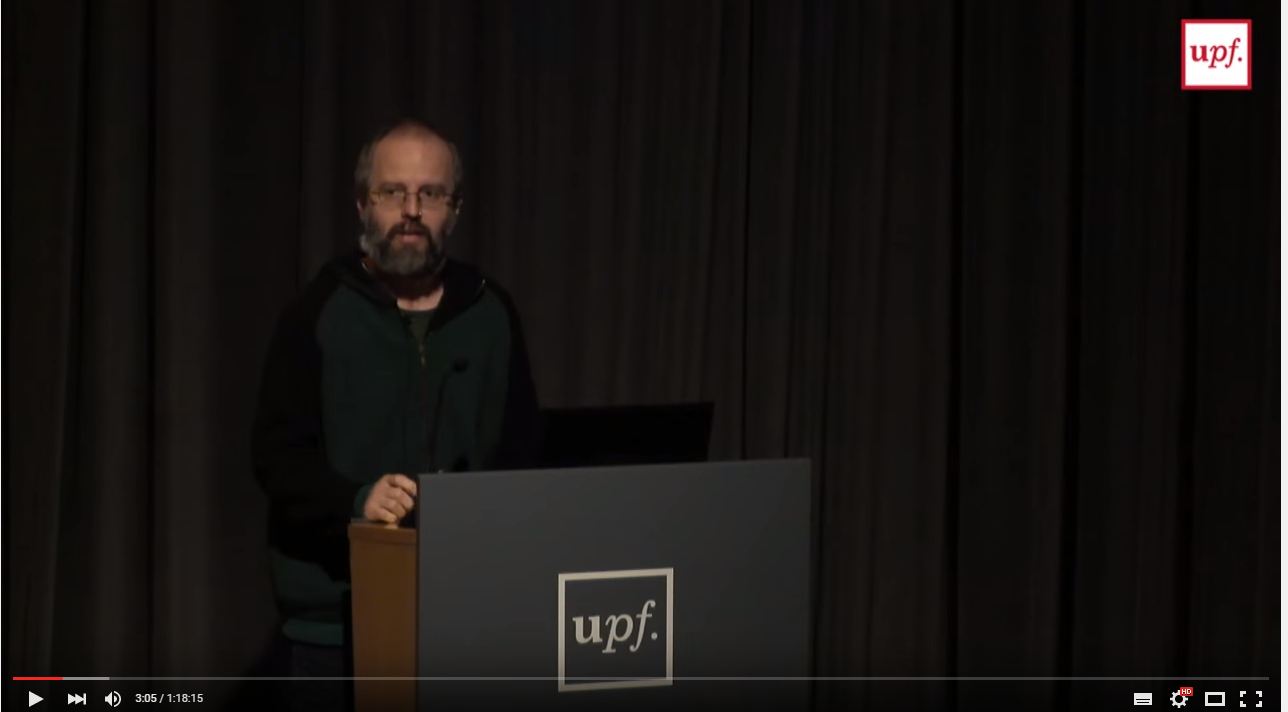 Despite that nowadays most cameras, even low-end consumer models, record video that when displayed on any common screen looks good and appears faithful to the original scene, on closer inspection the latter is never the case: there are details, visible at the scene, that are lost in the picture; conversely, there are details that we may only see in the picture, but were not noticeable at the scene; and colors never quite match, they don’t have the same shade, or saturation or brightness as in the original location. It is due to camera and display limitations that the shooting location and the images on the screen are perceived very differently. Adding extra lights on the location helps to improve image contrast, but this isn’t usually enough, and it’s also a very time consuming and expensive process. Trying to overcome the difference in display capabilities, professional movies are color-corrected shot by shot by skilled technicians, to generate outputs for different targets (e.g. digital cinema projectors and standard definition TV), but the results leave much room for improvement.This talk will present an overview of our ongoing work in image processing algorithms for cinema aiming to allow people watching a movie on a screen to see the same details and colors as people at the shooting location can. Despite that nowadays most cameras, even low-end consumer models, record video that when displayed on any common screen looks good and appears faithful to the original scene, on closer inspection the latter is never the case: there are details, visible at the scene, that are lost in the picture; conversely, there are details that we may only see in the picture, but were not noticeable at the scene; and colors never quite match, they don’t have the same shade, or saturation or brightness as in the original location. It is due to camera and display limitations that the shooting location and the images on the screen are perceived very differently. Adding extra lights on the location helps to improve image contrast, but this isn’t usually enough, and it’s also a very time consuming and expensive process. Trying to overcome the difference in display capabilities, professional movies are color-corrected shot by shot by skilled technicians, to generate outputs for different targets (e.g. digital cinema projectors and standard definition TV), but the results leave much room for improvement.This talk will present an overview of our ongoing work in image processing algorithms for cinema aiming to allow people watching a movie on a screen to see the same details and colors as people at the shooting location can.
|
Nov 19th, 2015 13:00
Auditorium |
Natural language processing: From a playground of some to a central technology of many
by Leo Wanner
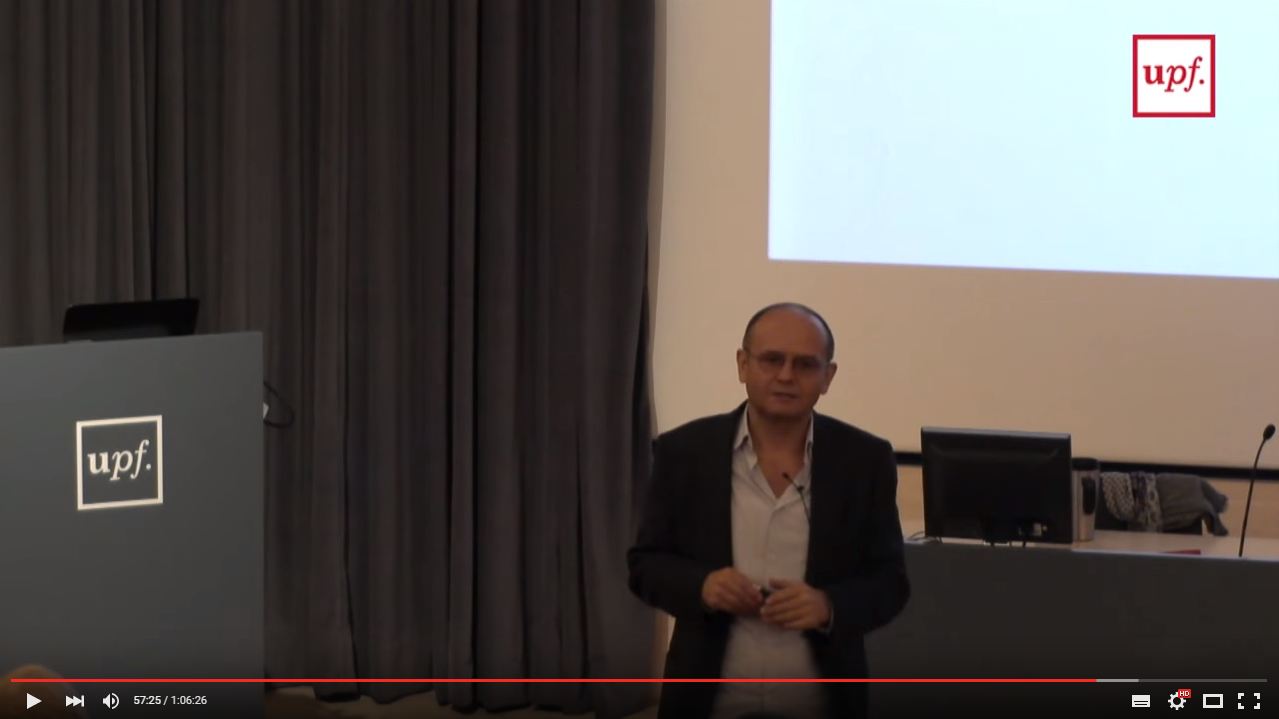 The computational modelling and processing of natural language (in Artificial Intelligence referred to as "Natural Language Processing" and in Linguistics as "Computational Linguistics") has been a long time a rather isolated research field. The appearance of the world wide web, the increasing popularity of intelligentagents, and the availability of large volumes of (annotated) data led to a signicant change of the perceptionof the field beyond its frontiers. Nowadays, natural language processing (NLP) technologies are central tomany information communication and processing applications - including information search and extraction,human computer interaction, decision support engines, knowledge acquisition, etc. In the first part of this talk, we will present the state-of-the-art research carried out in the TALN group in various areas of NLP, spanning over multilingual syntactic and deep parsing, text summarization, paraphrasing and simplication, text and spoken language generation, author profiling and second language learning to more practical applications such as distillation of gists from patent material and the use of visual analytics for navigation in large scale content spaces. We will show how more classical graph transduction strategies from theoretical computer science can complement advanced machine learning-based techniques to achieve the best performance. In the second part of the talk, we will discuss how NLP can complement broader information processing technologies and illustrate this complementation drawing upon our past and current collaborative initiatives, both within the DTIC and outside. The computational modelling and processing of natural language (in Artificial Intelligence referred to as "Natural Language Processing" and in Linguistics as "Computational Linguistics") has been a long time a rather isolated research field. The appearance of the world wide web, the increasing popularity of intelligentagents, and the availability of large volumes of (annotated) data led to a signicant change of the perceptionof the field beyond its frontiers. Nowadays, natural language processing (NLP) technologies are central tomany information communication and processing applications - including information search and extraction,human computer interaction, decision support engines, knowledge acquisition, etc. In the first part of this talk, we will present the state-of-the-art research carried out in the TALN group in various areas of NLP, spanning over multilingual syntactic and deep parsing, text summarization, paraphrasing and simplication, text and spoken language generation, author profiling and second language learning to more practical applications such as distillation of gists from patent material and the use of visual analytics for navigation in large scale content spaces. We will show how more classical graph transduction strategies from theoretical computer science can complement advanced machine learning-based techniques to achieve the best performance. In the second part of the talk, we will discuss how NLP can complement broader information processing technologies and illustrate this complementation drawing upon our past and current collaborative initiatives, both within the DTIC and outside.
|
|
Oct 22nd, 2015
13:00
Auditorium
|
Why is our nonlinear time series analysis group not linear?
by Ralph Andrzejak
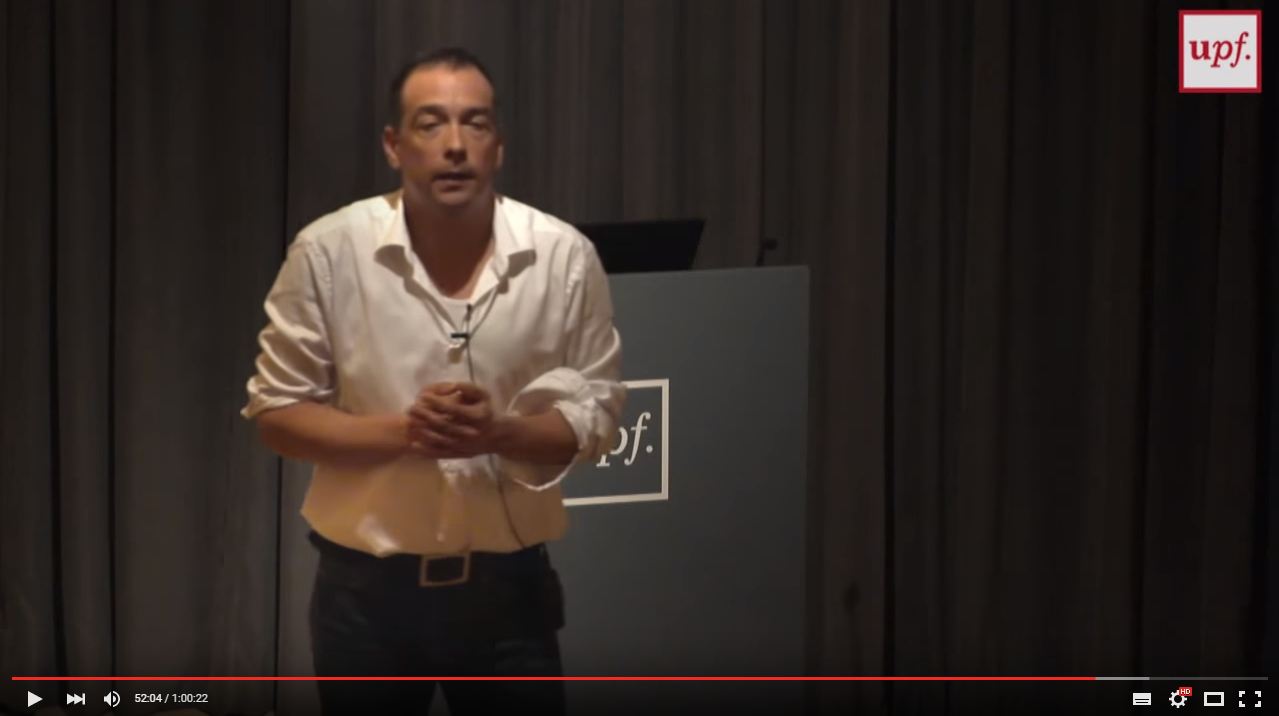 Nonlinear time series analysis allows characterizing dynamical systems in which nonlinearity gives rise to a complex, seemingly irregular temporal evolution. Importantly, these nonlinear techniques can extract information from real-world experimental signals that cannot be resolved by classical linear techniques, such as spectral analysis. Nonlinear time series analysis can, for example, help to discriminate nonlinear deterministic and linear stochastic dynamics or to characterize directional interactions between dynamics. In application to signals measured from the brain, this analysis can contribute to the understanding of brain functions and dysfunctions. It can thereby advance cognitive neuroscience and neurology. Nonlinear time series analysis allows characterizing dynamical systems in which nonlinearity gives rise to a complex, seemingly irregular temporal evolution. Importantly, these nonlinear techniques can extract information from real-world experimental signals that cannot be resolved by classical linear techniques, such as spectral analysis. Nonlinear time series analysis can, for example, help to discriminate nonlinear deterministic and linear stochastic dynamics or to characterize directional interactions between dynamics. In application to signals measured from the brain, this analysis can contribute to the understanding of brain functions and dysfunctions. It can thereby advance cognitive neuroscience and neurology.
In this seminar, I will at first illustrate some fundamental concepts of nonlinear time series analysis. Subsequently, we will review some basic facts about the disease epilepsy, epilepsy surgery and intracranial electroencephalographic recordings (EEG) from epilepsy patients. I will then show an application of nonlinear time series analysis to EEG recordings from the seizure-free interval of epilepsy patients undergoing pre-surgical diagnostics. Results of this application allowed us to localize the seizure generating brain area without the necessity of observing actual seizure activity – a finding of clear clinical relevance.
|
Jul 10th, 2015 12:30
Auditorium |
Some GTI Research: HCI in the Wild and Democratisation of 3D Graphics
by Josep Blat
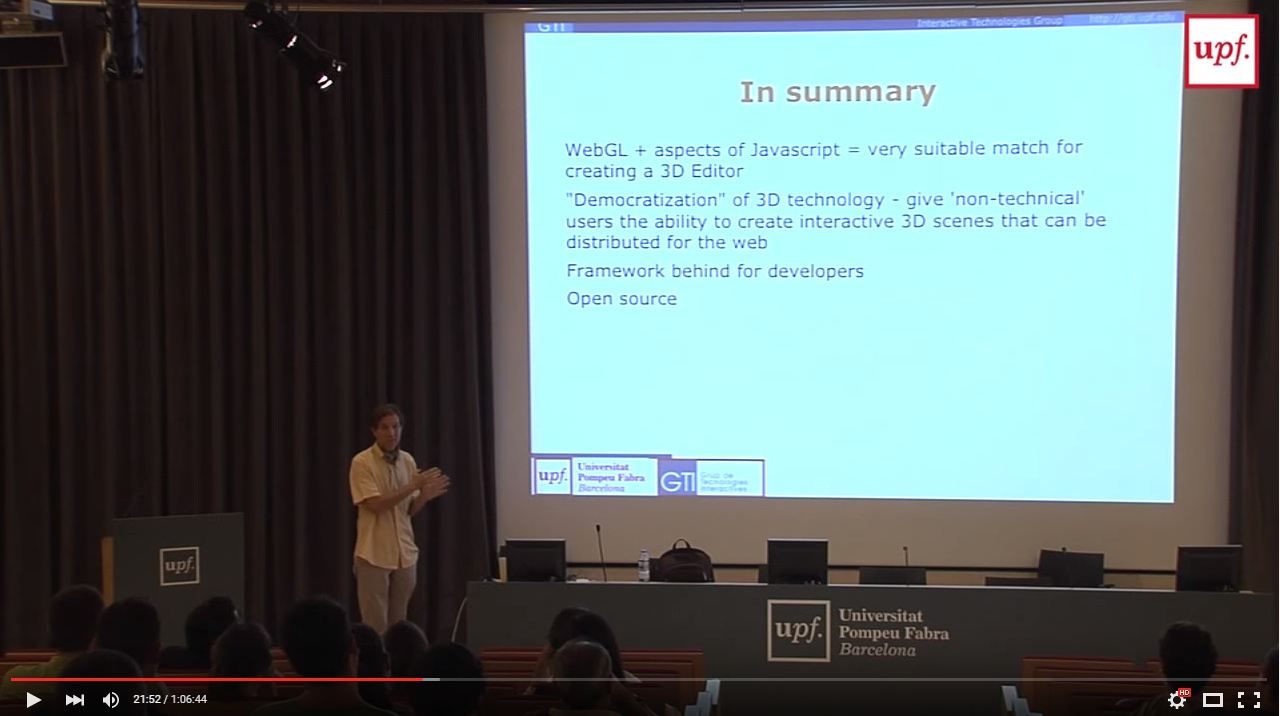 Some of the ongoing research in HCI and CG, 2 of the 3 areas GTI works on (the third being Technology Enhanced Learning), will be discussed, framed in ongoing research trends, the so called "HCI in the wild", and democratisation of 3D graphics, respectively Some of the ongoing research in HCI and CG, 2 of the 3 areas GTI works on (the third being Technology Enhanced Learning), will be discussed, framed in ongoing research trends, the so called "HCI in the wild", and democratisation of 3D graphics, respectively
|
Jun 4th, 2015
13:00
Auditorium |
Research highlights in my journey within the field of Sound and Music Computing
by Xavier Serra
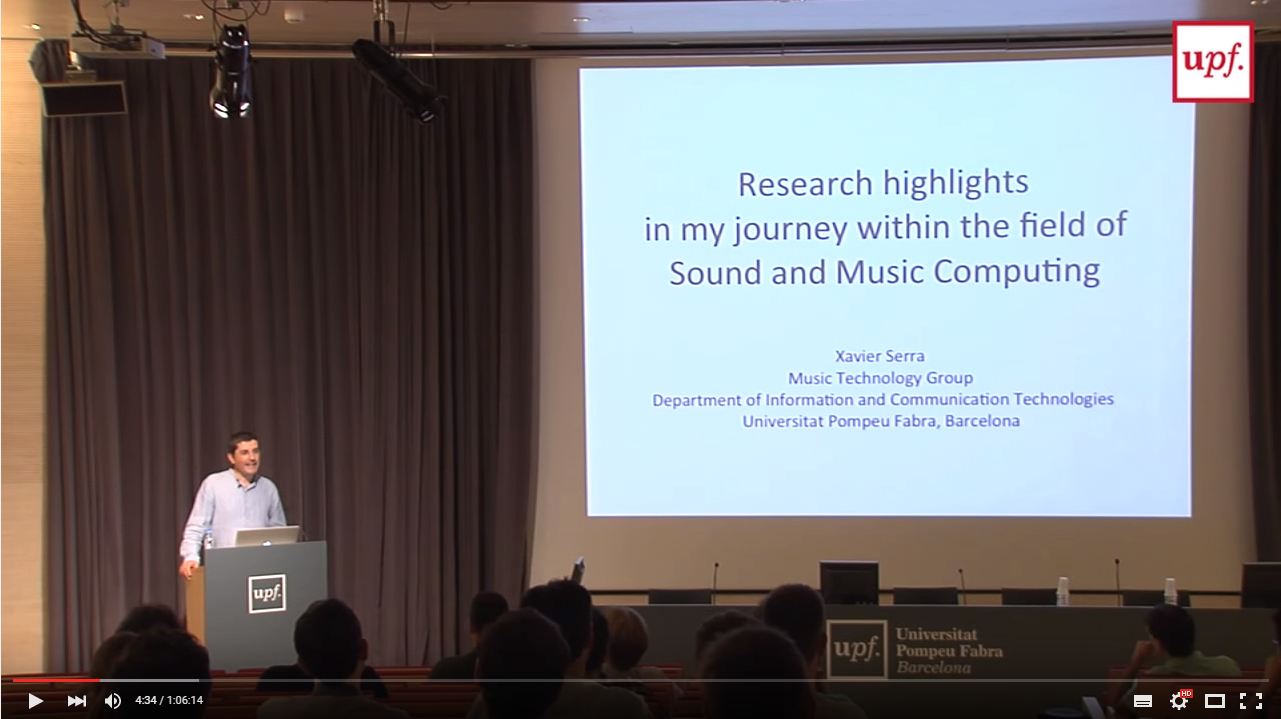 In this presentation I will go over some of the research I have been involved with in my thirty-year career within the field of Sound and Music Computing, emphasizing the goals I aimed for and identifying some of the results obtained. In this presentation I will go over some of the research I have been involved with in my thirty-year career within the field of Sound and Music Computing, emphasizing the goals I aimed for and identifying some of the results obtained.
My personal research, and the one I have directly supervised, has been mainly focused on the analysis, description and synthesis of sound and music signals. My initial efforts were dedicated to analyze and transform complex and musically relevant sounds; sounds that were not well captured by the audio processing techniques used at that time. My approach was to use spectral analysis and synthesis techniques to develop a deterministic plus stochastic model with which to obtain sonically and musically meaningful parameterizations and descriptions. That work had practical applications for synthesizing and transforming a wide variety of sounds, including the voice.
My research has always been motivated by music, by the interest of developing musical tools that can be socially and culturally relevant. In this talk I want to emphasize this aspect while talking about my thirty-year research journey.
|
Apr 10th, 2015 13:00
Auditorium |
Where engineering meets clinical practice: understanding the working of the heart in health and disease
by Bart Bijnens
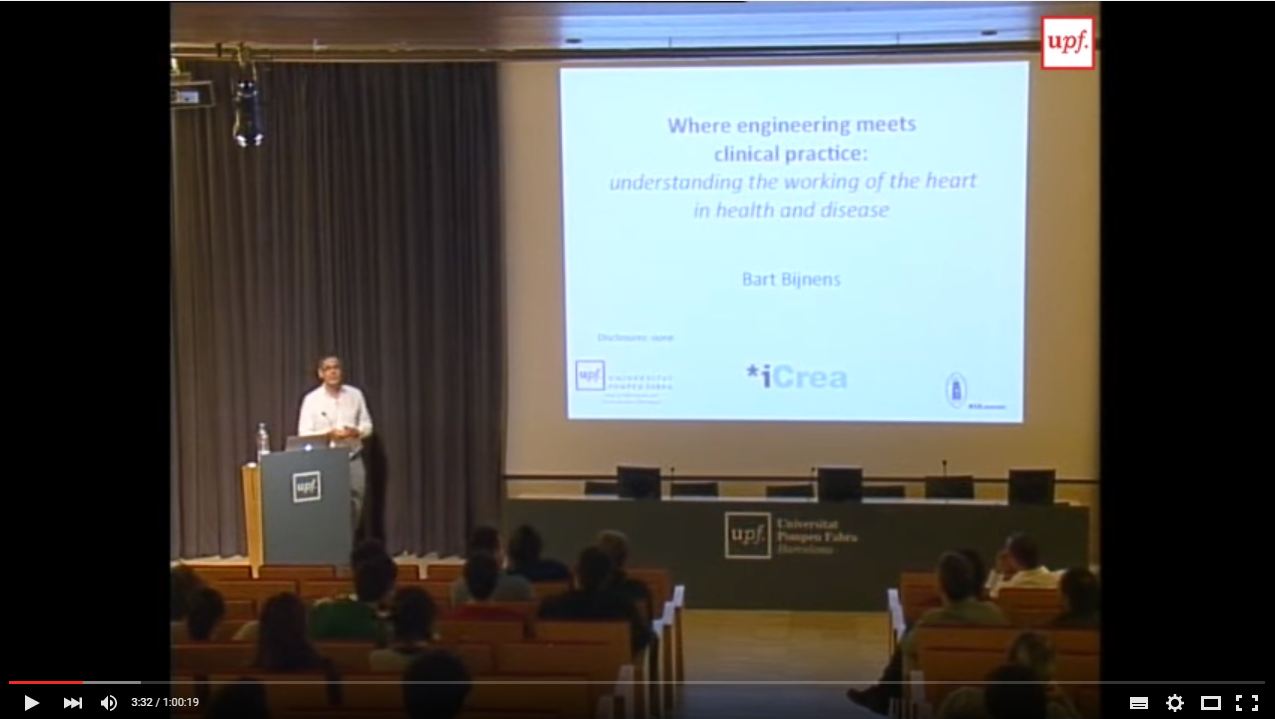 Contemporary research in cardiovascular medicine is aimed at both the understanding of the fundamental properties of the cardiovascular system and its changes with disease, as well as providing evidence-based guidelines towards best clinical practice. Linking basic understanding with clinical practice is the objective of translational biomedicine, in which "reality-driven" research is key, underlining the concept that direct human observations are essential for the study of hypotheses relevant to human reality [Mankoff S, Journal of Translational Medicine 2004]. However, reality-driven biomedical research is accompanied by important hurdles since interpreting complex observations and linking these to relevant basic and clinical understanding of the human and their diseases require an interaction of basic scientists from all disciplines, technologists and computer scientists and clinical specialists, all speaking different languages. Contemporary research in cardiovascular medicine is aimed at both the understanding of the fundamental properties of the cardiovascular system and its changes with disease, as well as providing evidence-based guidelines towards best clinical practice. Linking basic understanding with clinical practice is the objective of translational biomedicine, in which "reality-driven" research is key, underlining the concept that direct human observations are essential for the study of hypotheses relevant to human reality [Mankoff S, Journal of Translational Medicine 2004]. However, reality-driven biomedical research is accompanied by important hurdles since interpreting complex observations and linking these to relevant basic and clinical understanding of the human and their diseases require an interaction of basic scientists from all disciplines, technologists and computer scientists and clinical specialists, all speaking different languages.
|




